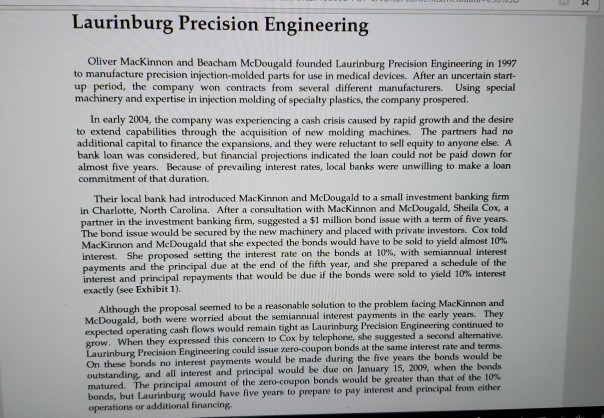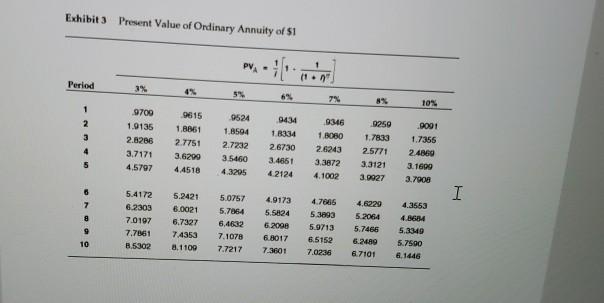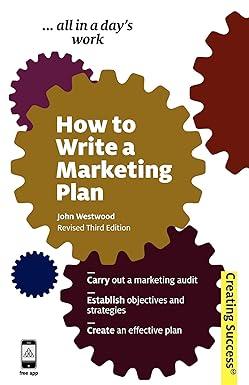Answered step by step
Verified Expert Solution
Question
1 Approved Answer
Laurinburg Precision Engineering Oliver MacKinnon and Beacham McDougald founded Laurinburg Precision Engineering in 1997 to manufacture precision injection-molded parts for use in medical devices. After




Laurinburg Precision Engineering Oliver MacKinnon and Beacham McDougald founded Laurinburg Precision Engineering in 1997 to manufacture precision injection-molded parts for use in medical devices. After an uncertain start up period, the company won contracts from several different manufacturers. Using special machinery and expertise in injection molding of specialty plastics, the company prospered In early 2004, the company was experiencing a cash crisis caused by rapid growth and the desire to extend capabilities through the acquisition of new molding machines. The partners had no additional capital to finance the expansions, and they were reluctant to sell equity to anyone else. A bank loan was considered, but financial projections indicated the loan could not be paid down for almost five years. Because of prevailing interest rates, local banks were unwilling to make a loan commitment of that duration. Their local bank had introduced MacKinnon and McDougald to a small investment banking firm in Charlotte, North Carolina. After a consultation with MacKinnon and McDougald, Sheila Cox, a partner in the investment banking firm, suggested a $1 million bond issue with a term of five years. The bond issue would be secured by the new machinery and placed with private investors. Cox told MacKinnon and McDougald that she expected the bonds would have to be sold to yield almost 10% interest. She proposed setting the interest rate on the bonds at 10%, with semiannual interest payments and the principal due at the end of the fifth year, and she prepared a schedule of the interest and principal repayments that would be due if the bonds were sold to yield 10% interest exactly (see Exhibit 1) I seemed to be a reasonable solution to the problem facing MacKinnon and McDougald, bot expected operating cash flows would remain tight as Laurinburg Precision Engineering continued to grow. When they expressed this concern to Cox by telephone, she suggesteda Laurinburg Precision Engineering could issue zero-co On these bonds no interest payments would be made during the five years the bonds would be h were worried about the semiannual interest payments in the early years upon bonds at the same interest rate and terms rest and principal would be due on January 15, 2009, when the bonds matured. The principal amount of the zero-coupon bonds would be greater than that of the 10% bonds, but Laurinburg would have five years to prepare to pay interest and principal from either operations or additional financing Questions 1. Using the present-value tables in Exhibits 2 and 3, estimate the number of zero- coupon bonds (each with a face value of $1,000) that will have to be offered to provide the $1 million Laurinburg Precision Engineering needs for expansion, if investors seek a yield of 10%. Assume interest will compound on a semiannual basis over the life of the five-year-bond issue. Prepare a schedule similar to Exhibit 1 that shows the interest expense and end-of-period bond liability for each semiannual compounding period. Why is the interest expense for the zero- coupon bonds different from the interest expense on the five-year bonds summarized in Exhibit 1? Exhibit 1 Schedule of Interest Payments, Interest Expense, and Bond Liability for a 10%, Five-year Bond with Semiannual Interest Payments issued to Yield 10% Interest Interest Payment Interest Principal to be Paid Date xpense Carrying Value 1/15/2004 7/15/2004 1/15/2005 7/15/2005 1/15/2006 7/15/2006 1/15/2007 7/15/2007 1/15/2008 7/15/2008 $50,000 50,000 50,000 50,000 50,000 50,000 50,000 50,000 50,000 50,000 $50,000 50,000 50,000 50,000 50,000 50,000 50,000 50,000 50,000 50,000 $1,000,000 1,000,000 1,000,000 1,000,000 1,000,000 1,000,000 1,000,000 1,000,000 1,000,000 1,000,000 1,000,000 1/15/2009 $1,000,000 Exhibit 2 Present Value of $1 5% 6% 8% 10% Period .9434 8900 8638 83068163 9259 9091 9700 9426 9151 9615 9246 8800 9524 ,9070 9346 8734 873 8264 7938.7513 7350 6830 68066209 8227 7021 7620 8219 7836 7473 7130 8626 5645 8375 8131 7694 7664 7441 7903 7500 /307 7026 6756 7462 7107 6768 6446 6130 7050 6651 6274 6910 5584 6663 6227 6820 5430 58355132 5403 4665 .5002 4241 4632 3855 10 Exhibit 3 Present Value of Ordinary Annuity of $1 Period 3% 4% 5% 4% 10% 9709-96 1 5 .9524 .9434 .9346 .9259 .9091 .9135 1861 1,8594 18334 18080 1.7833 1,7355 2.8286 2.775 2.7232 2.6730 2.6243 2.5771 2.4860 3.7171 3.6299 3.5460 3.4651 3.3872 3.3121 31699 4.57974.4518 4.3295 4.2124 4.1002 3.9927 37908 5.4172 5.2421 5.0757 4.9173 4.7665 4.6229 4.3553 6.2303 60021 5.7864 5.5824 5.3693 5.2064 4.8684 7.0197 6.7327 6.4632 6.098 5.9713 5.7466 5.3349 7.7061 743537.1078 68017 6512 6.2489 5.7500 8.5302 8.1109 7.7217 7.3601 7.0236 6.7101 6.1446 10
Step by Step Solution
There are 3 Steps involved in it
Step: 1

Get Instant Access to Expert-Tailored Solutions
See step-by-step solutions with expert insights and AI powered tools for academic success
Step: 2

Step: 3

Ace Your Homework with AI
Get the answers you need in no time with our AI-driven, step-by-step assistance
Get Started


